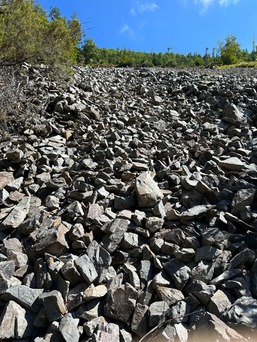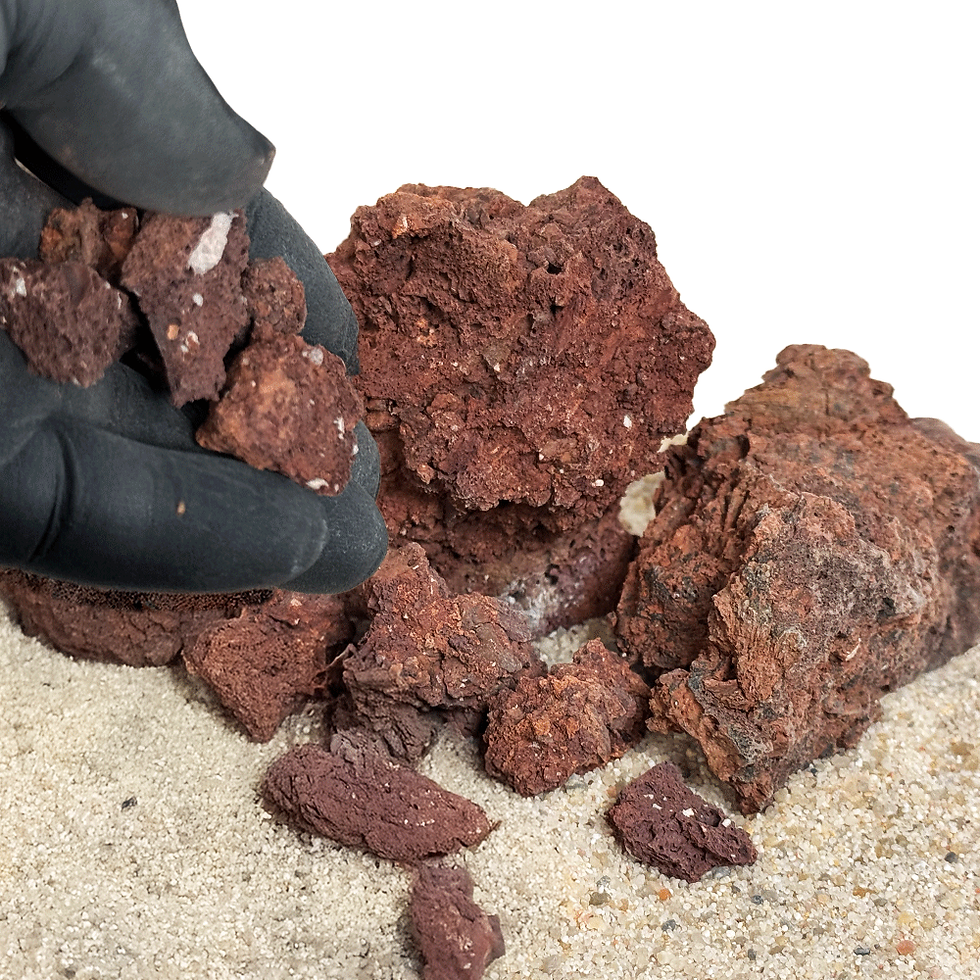Small Details, Big Impact: WIO Accents
- Sales
- 8 hours ago
- 7 min read
How the tiniest moves—chips, litter, and drift—turn layouts into living places
This story listens to how nature places its small things—chips at a slope’s toe, pebbles wedged in seams, driftwood on a high line—and translates that grammar into an aquascape, terrarium, or paludarium you can make at home. Whether you start with WIO’s curated Accent Chips palettes or compose from first principles, you’ll use micro‑textures to bind banks, soften joins, and guide the eye so your scene stops posing and starts breathing. Each Accent line is named by color or stone family (Dragon, Volcanic, Black, Grey, Warm Grey, Brown, Red, Yellow, Pale)—so there’s an accent for every stone, and pairing is instant and precise. We’ll map aesthetics to ecology (function over ornament), stay honest about chemistry, and give you two build paths: field-built from parts or pre-matched accents for speed and precision.
The Listening Moment
Pinch a spoon of chips and let them fall. Hear the faint rattle as pieces nest where gravity wants them. A sliver skates downslope, a larger fragment parks at a stone’s foot, a fleck vanishes into a crease. That’s nature’s hand. Your job is to follow it.
Why Small Accents Work (Underlying Science, Simply)
Water sorts, wind sorts, gravity sorts. Faster water carries fines and leaves heft; slower water drops silt in lee pockets. Gravity drags fragments to the base of slopes (scree). Wind makes drift lines and deposits litter behind obstacles. Over time these forces draw believable patterns:
Toe piles at the bottom of banks (coarse → medium → fine as you step away).
Seam fills where pebbles wedge between bigger stones.
Drift & litter lines perched a little higher than daily water, telling of past floods.
Micro relief that catches light and makes depth read from across the room. Accents recreate these micro-structures. The eye accepts the story because the physics underneath are true.
Field Note — Nature’s order in a handful: coarse clusters at anchor stones; fines tapering like a comet tail in the lee; one honest snag of twig where current once eased.
Function Map (Biomimicry → Purpose)
Stone chips (granite, dragon/ohko, river pebbles):
Aesthetic: erase sterile seams, bridge big-to-small transitions, extend “bedrock” into ground.
Ecological: reduce detritus traps by smoothing gaps; create graze edges for periphyton.
Crushed lava (dark or red):
Aesthetic: dramatic contrast, porous texture that reads “wild.”
Ecological: high surface area for microbes; in terraria, holds moisture in the first 5–10 mm.
Wood & botanical litter (bark curls, seed pods, leaves):
Aesthetic: Wabi‑Sabi patina; seasonal story.
Ecological: biofilm food web; tannin release (water tint, mild pH effects in low buffer); isopod/springtail cover.
WIO Insight Function before looks: if a placement can’t be explained by flow, gravity, or wind, don’t do it.
The Living Layer
Every accent becomes habitat. In aquaria, chips and porous lava multiply surfaces for nitrifiers and grazers; “lee pockets” become controlled detritus gardens you can reach. In paludaria and terraria, lava and bark keep the moisture micro‑climate stable between misting cycles; fungal threads and springtails turn litter into a slow nutrient engine. Patina is not mess—it’s life maturing.
Field Trick—Ten‑second flow test: dust a pinch of fine food or dried spirulina in front of your intake. Where it settles is where your fines—and your shrimp—will farm. Place chips to guide that lane, not fight it.
Accent Chips by Stone (Targeted Pairing)
Match every WIO stone family with its purpose-built Accent Chips. Each chip line is named by color or stone type so pairing is intuitive and the scene reads as one material story.
Volcanic (Inert)
Dark Lava Chips — deep grey→black, porous. Pairs with: Black Darwin Lava, Druid boulders. Why: shadow, contrast, and slope binding without chemistry drift. Water chemistry: inert.
Red Lava Chips — brick/terracotta. Pairs with: Wild Red Lava stone. Why: warm depth and porous micro‑texture. Water chemistry: inert.
Dragon (Inert)
Dragon Chips — warm ochre/yellow with brown shades. Pairs with: Dragon (Ohko) Stone exclusively or any warm ochre set. Why: mirrors Dragon’s layered fracture and ties bases into ground. Water chemistry: inert.
Dark Spectrum Greys (Mineral; may slightly raise pH/kH)
Black Chips — charcoal/jet. Pairs with: Black Venom and very dark stones. Why: erase seams around black anchors; carve shadow lanes. Chemistry: may slightly raise pH/kH in very soft water; monitor.
Dark Grey Chips — slate/charcoal. Pairs with: Dali, Wild Rhino, Black Ryuoh, Dark Seiryu, Hakkai. Why:coherent cool‑dark transitions and scree. Chemistry: may slightly raise pH/kH.
Neutral/Cool Greys (Mineral; may slightly raise pH/kH)
Grey Chips — neutral greys. Pairs with: Ryuoh, Seiryu, Millennium, Grey Fossil Wood. Why: refined seams and pathing that match classic grey beds.
Cold Grey Chips — steel‑cool. Pairs with: Seiryu, Ryuoh, Multilayer Stone, Grey Fossil Wood where a crisp tone is desired.
Warm Greys & Earths (Mineral; see product sheet)
Warm Grey Chips — sandstone/taupe. Pairs with: Elderly/Elderly Boulder, Elephant Skin, Bumblebee, Manten. Why: warms edges, naturalizes layered outcrops. Chemistry: some variants may be inert; others can slightly raise pH/kH—check bag notes.
Brown Chips — sienna/umber. Pairs with: Elderly, Solar Eclipse, Hole Stone, Paleorock, Pagoda, Dragon, Fossil Stone. Why: grounds warm sedimentary palettes. Chemistry: may slightly raise pH/kH.
Color Accents (Mineral; may slightly raise pH/kH)
Red Chips — deep rust/terracotta. Pairs with: Inferno Stone.
Yellow Chips — honey/ochre. Pairs with: Bumblebee Stone.
Pale Chips — chalk/ivory. Pairs with: White Adder, Hole Stone and other pale sets.
Chemistry, kept honest: Lava (Dark/Red) and Dragon Chips are inert and won’t alter pH/kH. Mineral chip families (Black, Dark Grey, Grey, Cold/Warm Grey, Brown, Red, Yellow, Pale) may contain traces of calcareous minerals and can slightly lift pH/kH in very soft water—monitor and choose intentionally.
Placement rule of thumb: heavy at stone feet → taper downslope; keep the lane open.
Product Spotlight — Wood Sinking Chips (for litter realism)
A curated mix of bark, fine roots, twigs, and wood litter that sinks after curing. Use to soften stone feet, frame drift lines, and feed microfauna. Chemistry: releases tannins; can lower pH in low‑buffer water—introduce gradually after boiling ~20 min or soaking 24–72 h; packaging 150 g.
Where to place: pockets behind stones, the toe of slopes, and along high‑water drift lines—never blanket the lane.
Chooser Micro‑Quiz (Pick fast, build faster)
Mood: shadowy drama or sunlit ochre? → Drama: Dark Lava. Sunlit: Dragon. Warm earth: Red Lava.
Livestock/Critters: soft‑water shrimp & grazers or hard‑water cichlids/snails? → Soft: any lava + wood litter. Hard: avoid heavy botanicals; lean mineral, keep chips inert.
Room tone: cool & crisp or warm & mellow? → Cool: Dark Lava. Warm: Red Lava/Dragon.
Maintenance appetite: spartan or ornate? → Spartan: sparse chips, big negative space. Ornate: richer seam fills + a single litter “jam.”
Design Moves (Make it read as real)
Negative space discipline: keep an open corridor; never carpet the lane.
Rule of odds: bind banks with 3/5/7 anchor stones; use chips to “feather” edges.
Texture rhythm: grade fine → medium → coarse; repeat shapes at different scales.
One honest flaw: a small wood “jam” near a cobble; a slightly scuffed inner bar.
Seam literacy: push chips into joints until they lock; scatter a light “tail” downslope.
WIO Tip — Photographing chips: side‑light at a low angle; chips cast micro‑shadows that reveal relief and depth.
Build Steps (How‑To)
Stage the story: decide mood and corridor; mark the lane with fine sand (aquaria) or a dry “path” (terraria).
Anchor & grade: set 3–5 anchors; bank slopes at 10–20°. Grade substrate (fine inside → coarser outside).
Chip the seams: press larger chips at stone bases; fill joints until gaps disappear; trail fine fragments downslope.
Place litter with restraint: tuck bark/pods only in lee pockets; keep the lane clean.
Lock what moves: for steep faces, tack a few pieces with WIO ScapeGlue with matching ColorFuse on dry stone, then mist to set (aquaria) or let cure (terraria).
Fill & check: in aquaria, plate‑pour water; watch for scour and top up chips where needed. In paludaria, mist and observe how moisture wicks through lava.
Tune & photograph: adjust flow/light/humidity so micro‑relief reads; shoot before/after for learning.
Quick Start (5‑Step Recap)
Pick story (by stone family → matching Accent Chips).
Bag math: as a rule, 1 bag per accent type covers seams and pockets up to a 60P; use 2 bags for 90P–120P. (Most mineral chips: 750 g; Lava/Dragon: 500 g.)
Lay lane, anchor stones, and slope.
Press chips into seams; scatter tails; tuck minimal litter.
Tune flow/light/humidity; siphon or spot‑vac along the lane.
Chemistry, Kept Honest
Inert: Dark Lava Chip, Red Lava Chip, Dragon Chip (non‑calcareous).
Tannin‑active: wood & botanicals; may lower pH in low‑buffer water and tint amber—beautiful when planned.
Testing: watch pH, kH, gH, and conductivity (where relevant). Make small, slow changes; stability beats chasing numbers.
WIO Ethos — Materials with a conscience: approved, sustainable sources; never beach/river‑mined sands. Rinse with water only; no soaps or detergents. Quarantine botanicals when appropriate. Never release organisms to the wild.
Highlight: The Three New Accents (September Launch)
Dragon Chips — warm ochre/yellow with brown shades; pairs with Dragon (Ohko) Stone to mirror its layered fracture; stabilizes slopes; inert and shrimp‑safe.
Dark Lava Chips — deep greys to jet black; porous and dramatic; pairs with Black Darwin Lava and Druid boulders; chemistry inert.
Red Lava Chips — brick to terracotta rust; pairs with Wild Red Lava stone for warm, volcanic relief; inert and easy to place.
WIO Tip — Use less than you think: most layouts read better when 70–80% of the lane remains visible. Accents belong at edges and in pockets, not everywhere.
FAQ
How much accent do I need? 1–2 kg covers seams and pockets of a 60–90 cm tank; terraria vary, start small and iterate.
Will lava chips alter pH or kH? No—Dark and Red Lava Chips are inert.
Do Dragon Chips crumble? They’re pre‑washed and sized to avoid clay fines; rinse lightly before use and avoid crushing with heavy tools.
Are botanicals safe with shrimp or soft‑water fish? Yes when cured slowly; expect amber tint and a mild pH dip in low‑buffer water—monitor and proceed in stages.
How do I keep chips on steep banks? Use gravity first (press and wedge), then a few dots of cyanoacrylate gel on dry stone for insurance.
Will accents trap detritus? Proper seam fills reduce voids; place pockets intentionally so you can siphon or spot‑vac them.
Can I use accents in paludaria/terraria? Yes—lava excels as moisture reservoir; bark/pods feed the clean‑up crew (springtails/isopods).
How do I clean without ruining the scene? In aquaria, siphon along the lane and behind cobbles; replace a pinch of chips if you lift any. In terraria, lift debris with tweezers and a soft brush.
Key Takeaways
Small accents translate real physics (flow, gravity, wind) into believable scenes.
Use chips to erase seams, bind slopes, and guide the eye; keep the lane open.
Dark/Red Lava and Dragon Chips are inert; wood/botanicals add patina and tannins.
Less is more: cluster, tail, and stop.
Plan for patina; maintain pockets you can reach.






























Comments